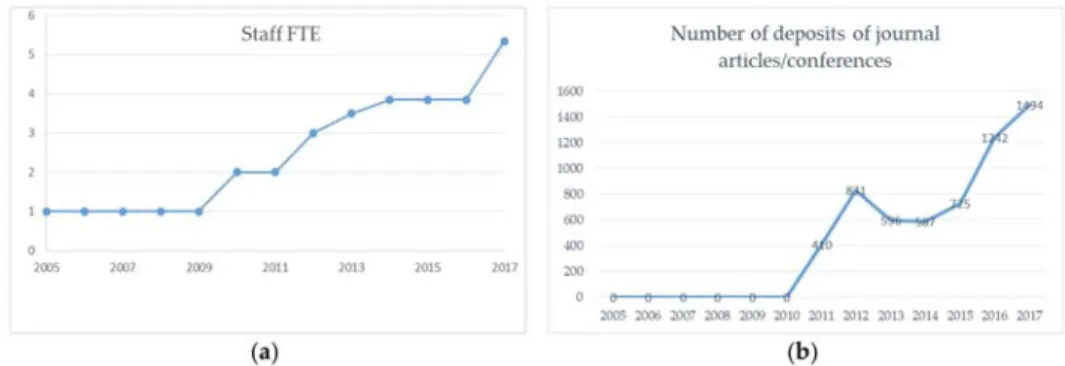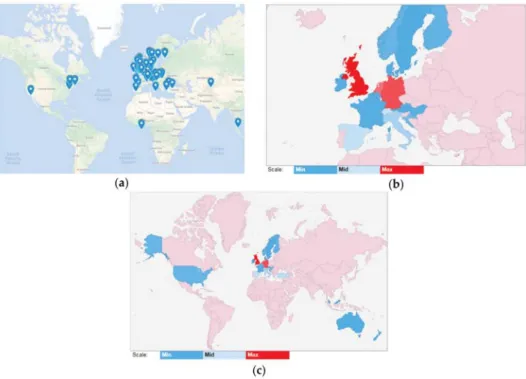In this role, she is responsible for all services, activities and projects regarding Open Access and research data at the University of Konstanz. This special issue examines some of the changes in today's library services that relate to open access.
Engaging and Supporting a University Press Scholarly Community
- Introduction
- Developing Resources for Our Community
- Publication Workflow
- Support Infrastructure
- Supporting Student Authors
- Conclusions
Press was created in 2007 as a result of the personal interest in open access of the then repository manager. This is something that Press plans to incorporate into the publication workflow for our next edition of Field.
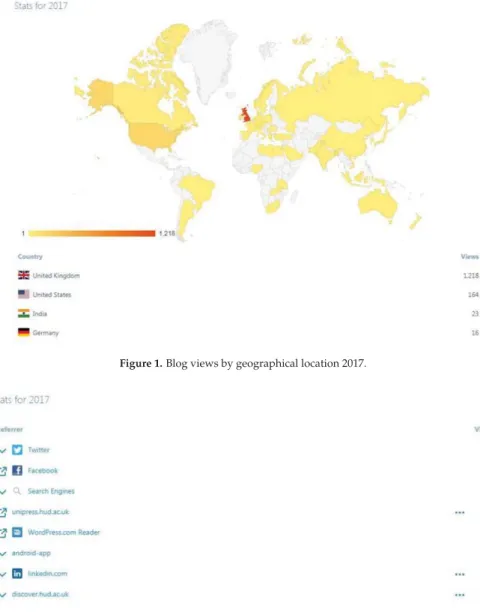
Library-Mediated Deposit: A Gift to Researchers or a Curse on Open Access? Reflections from the Case
- Background in the UK: The Shift from Good Practice to Compliance
- The Case Study: University of Surrey and Open Access
- Discussion
- Conclusions
In the United Kingdom, several developments have allowed open access to become mainstream and formally embedded in research practice. In response to these changes, both the deposit rate of new publications and the size of the Open Access team increased in parallel.
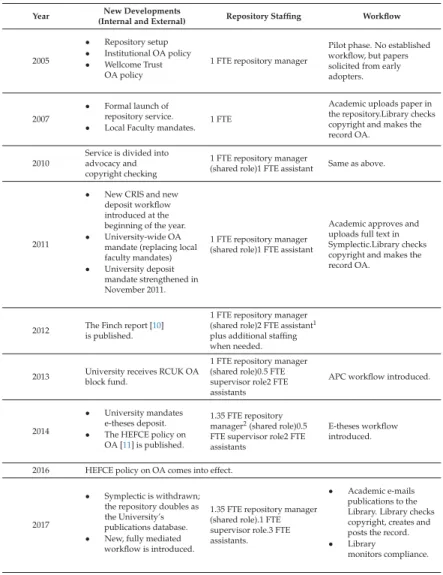
Enhancing Institutional Publication Data Using Emergent Open Science Services
Materials and Methods
All software [24] and associated data results [25] produced during the study are published online and described in the supplementary data section. As mentioned in the introduction, the study uses two classification schemes; 'best location', which highlights publication trends and whether OA diffusion has occurred, and 'all locations', showing the diversity of papers in OA distribution patterns.
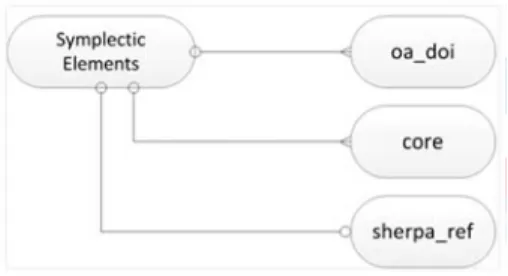
Results
To distinguish between disciplinary repositories and IR locations, we excluded outputs found by Unpaywall that have the identifier oai:bura (Brunel Local IR - Brunel University Research Archive). There seems to be a fair amount of OA sites where gold and green hosts are available.
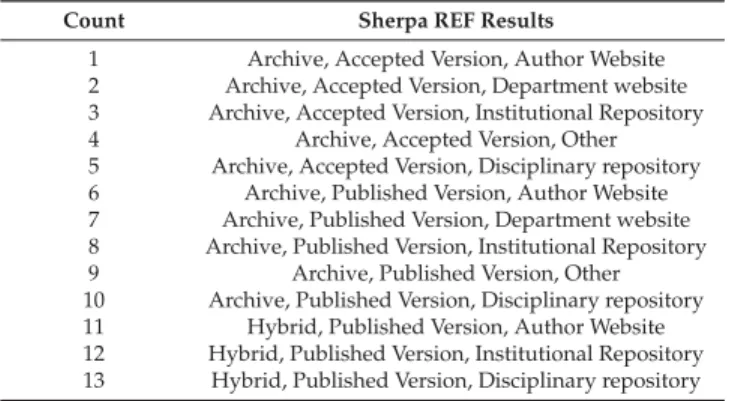
Supporting Open Access at Kent—New Staff Roles
- Introduction, Historical Position, and the UK Open Access Policy Framework
- The changes Made
- The New Structure in Detail
- How does This Compare to Elsewhere?
- Benefits of the New Structure 1. Specialist Expertise in Open Access
- Challenges of the New Structure 1. Competing Time Demands
Full-text submissions were encouraged, but there was no specific advocacy for Open Access. The effect of these policies was for the University of Kent to publish its "Open Access Policy" [6]. The Faculty Librarian is responsible for open access guidelines, websites, training, inquiries and reporting.
The post's roles include monitoring and evaluating evolving Open Access needs and opportunities. Available online: https://wellcome.ac.uk/funding/managing-grant/open-access-policy (accessed 26 March 2018). Available online: https://www.jisc-collections.ac.uk/About-JISC-Collections/Supporting-transition-to-Open-Access/.
Preparing for the Research Excellence Framework: examples of open access good practice in the United Kingdom. Ser.
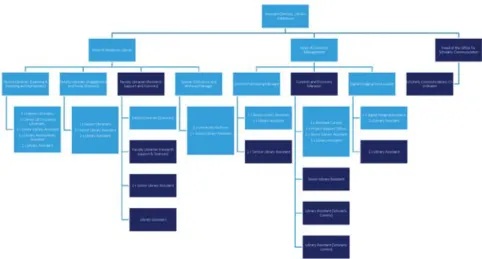
Open Science Support as a Portfolio of Services and Projects: From Awareness to Engagement
- Bridging the Gap between Policy and Practice
- Publishing Services and Research Support at Göttingen Campus
- Analyzing Scholarly Communication
- Transforming Acquisition Budgets from Subscriptions to Financing Open Access
- Research and Experiments as Facilitators of Open Science
Bringing open access forward has been defined as one of the strategic goals of the Göttingen State and University Library (SUB Göttingen)1. When it comes to creating open access and open science on the Göttingen Campus2, the university library is one of the most important actors, offering a wide range of open science services and activities. To bring open science to full acceptance, publishing opportunities for research results must be part of the picture, and open access currently seems to be the best fit for a changing research paradigm.
A funding requirement is the annual reporting of open access publications by researchers affiliated with the university. Some countries strongly advocate gold open access (UK, Netherlands), while the rest of the EU countries support a green or combined approach [28]. To end on a positive note, we have chosen a broad and inclusive perspective to foster involvement in promoting open access and open science at the University of Göttingen.
The state of osteoarthritis: a comprehensive analysis of the prevalence and impact of open access articles. PeerJ2018,6, e4375.
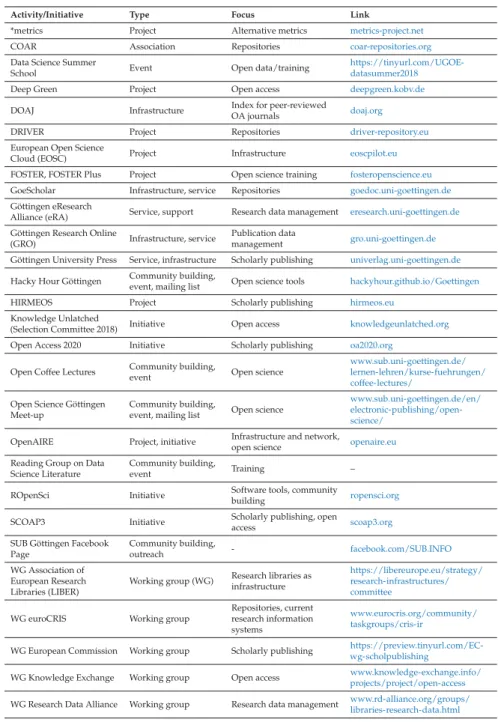
Data-Driven Transition: Joint Reporting of
Subscription Expenditure and Publication Costs
- Workflows for Collecting and Using Data on Publication Charges
- Electronic Resource Management System and Publications Database—Joint Reporting System During our search for methods of gathering data for joint reporting, we found that such methods
- Results and Further Use of Joint Reporting
- The Broader Perspective: A National Open Access Monitor for Germany
- Conclusions and Outlook
This section will introduce the relatively new roles of libraries in relation to open access publishing. Another idea would be to collect selected data from the Directorate of Open Access Journals (DOAJ) [27]. The visualization is presented as the Open Access Barometer [28] on the institution's website and constitutes an example of the visibility and further use of the data.
This was one of the reasons behind the establishment of the National Open Access Monitor in Germany. Academic publishing is currently a mixed economy consisting of both the open access model and the subscription model, and it will remain so for the foreseeable future. Article processing costs for open access publishing—The situation for research-intensive universities in the US and Canada.PeerJ2016,4, e2264.
Available online: https://www.tib.eu/en/publishing-archiving/open-access/financing-open-access/publishing-fund-leibniz-universitaet/ (accessed 13 February 2018).
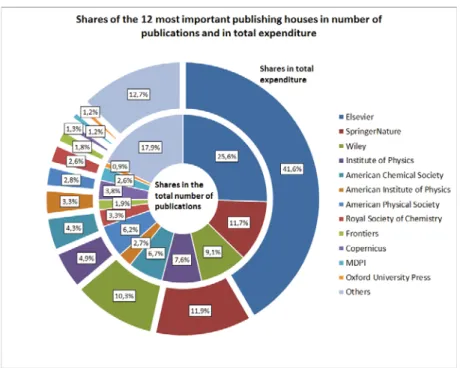
Getting Scientists Ready for Open Access
The Approaches of Forschungszentrum Jülich
Training Program
Most of the training then focused on publication fees and how they are dealt with at Forschungszentrum Jülich [6]. The aim of the training was to explain to the participants the main publication guidelines and to provide them with information and skills on the different aspects, especially the open access components. The content and design of the training explicitly include the creation of a common basis for all those present [22].
Apparently, the time period between enrollment and the training course was too long, and a recall may have increased the number of participants. The content of the training course was aimed at young scientists who have no or little experience in scientific publishing. The main part of the training course covered the workflow of publishing a peer-reviewed journal article.
The training ended with a summary of all the services offered by the central library for all phases of publishing.

Open Access Week
Central Library experts noted a lack of understanding of the difference between gold open access and green open access and the impact of these differences. Overall, this project in 2016 was deemed successful in raising awareness of the term open access at Forschungszentrum Jülich. On the eve of Open Access Week 2017, open access marketing activities intensified.
As part of this communication strategy, the "Open Access Week on Tour" series of events is planned to take place at some of the respective research institutes, presented by instructors from the Central Library and the library management. The modularized presentation included consistent parts such as general information and the services offered by the Central Library related to open access. It showed the current open access rate of Forschungszentrum Jülich (see Section 4 for detailed information) and compared it with the rate of the research institute.
One-third of the journals shown in the example are gold open-access journals, while two-thirds are closed-access journals.
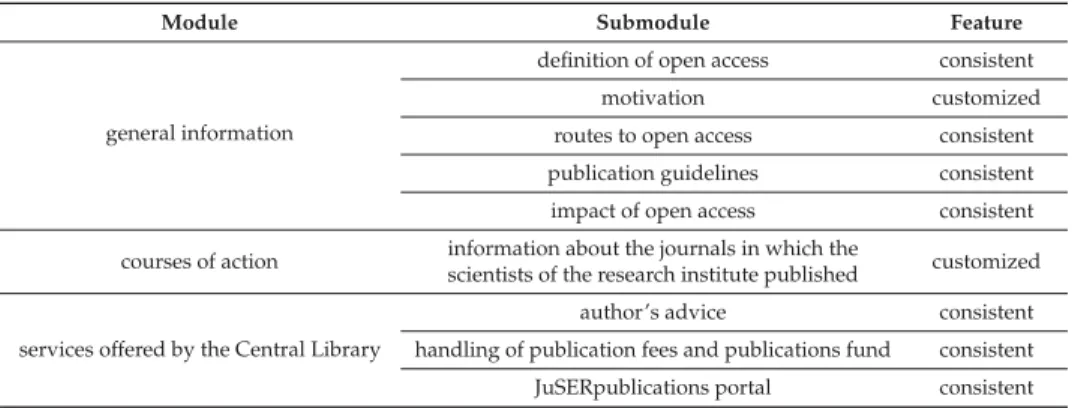
Results and Lessons Learned
Figure 3 shows the success of the approaches and efforts of the Central Library to prepare scientists for open access. In addition, many authors have also provided open access versions of their publications from previous years. The open access rate was again placed on the April agenda of the Jour Fixe of the Executive Board of Forschungszentrum Jülich in 2018.
The Central Library reported on the content of the events, the institutes visited and the improved open access percentage. Due to the objectives of the Helmholtz Association and the support of the Jülich board, the Central Library will continue to visit institutes in 2019 and include the concept of "Open Access Week on Tour" in its regular training program. Available online: http://os.helmholtz.de/open-science-in-der-helmholtz-gemeinschaft/open-access-richtlinien/open-access-richtlinie-der-helmholtz-geme inschaft-2016/open-access- policy-of-the-helmholtz-association-2016/(accessed 24 May 2018).
Open Access in Germany: the strategy of the German Federal Ministry of Education and Research.
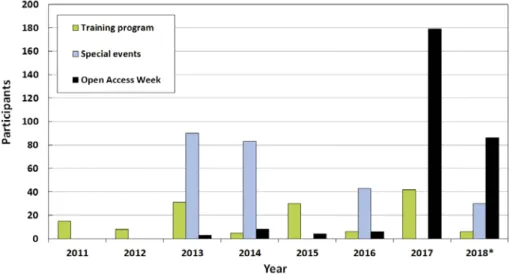
Converting the Literature of a Scientific Field to Open Access through Global Collaboration: The Experience
- Collaboration in Particle Physics (and Its Scholarly Communication)
- The SCOAP3 Business Model
- The SCOAP3 ‘Fair Share’ Principle
- The SCOAP3 Collaboration Structure
- Financial Results
- Conclusions and Recent Developments
Host organization' of the initiative in the same way it organizes experiments in accordance with. All of these participants are part of the SCOAP3 'recirculation of funds' business model, shown in Figure 1 and described below. To ensure that the SCOAP3 vision and CERN's own Open Access approach are constantly aligned, CERN is entitled to be a dedicated representative on SCOAP3's governing bodies.
Between 2014 and 2016, the SCOAP3 partnership distributed a total of €13.8 million to publishers for the creation of 13,368 Open Access articles. In April 2017, CERN and the American Physical Society (APS) announced that from January 2018, APS would participate in SCOAP3 with the HEP content of the three journals [23] and therefore increase SCOAP3 coverage to 89% of journal literature in this field. . The SCOAP3 Initiative and the Open Access Payload Processing Market: Global Partnership and Competition Improve Value in Science Dissemination.
This article is an open access article distributed under the terms and conditions of the Creative Commons Attribution (CC BY) license (http://creativecommons.org/licenses/by/4.0/).

Open Access in Vocational Education and Training Research
- A Research Project at the Federal Institute for Vocational Education and Training (BIBB) in Germany
- Open Access as an Area of Debate within Vocational Education and Training Research in Germany
- Background to the Research Project with Regard to Media Theory and Research on Science Communication
- Issues Leading the Research and Methodological Approach
BIBB thus plays a pioneering role in the field of open access in vocational education and training research. In this context, the question of the conditions of acceptance, dissemination and use of open access in vocational education and training research is of particular interest. In the field of science, technology and medicine (STM), OA is a well-established publishing model and its advantages are widely recognized [1] (p. 29).
The aspects and questions summarized in the RLTW Matrix show the complexity of the research object. This part consists of an online survey with a questionnaire focusing on selected conditions of acceptance, dissemination and use of Open Access in the field of vocational education and training research. In the humanities and social sciences, which include vocational education and training research, there is a greater limitation.
Open Access“ – Wandel des Publikationssystems für die wissenschaftliche Forschung.
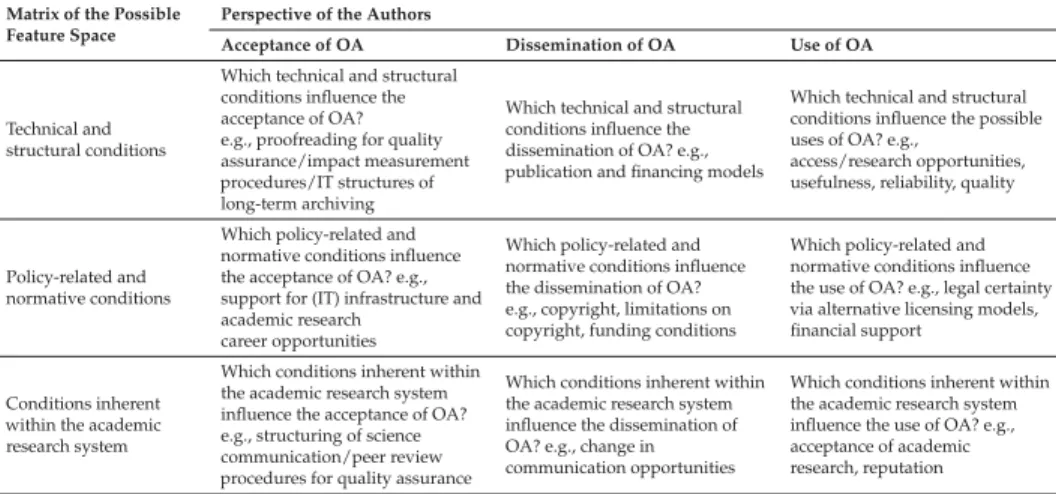
Opening the Heart of Science: A Review of the Changing Roles of Research Libraries
- Literature Search
- What Is (Really) Changing?
- The Future Is Now: RLUK, ARL and LIBER
- The Changing Roles of Research Libraries
- An Open Identity
New roles, their position in the research life cycle and their ability to change science itself are some of the aspects we will analyse. One of the key elements in the theoretical framework of the relationship between libraries and scientific research is the definition of "environmental change". Also, the dimension of cooperation is confirmed in three documents, especially the role of the research library as a learning center.
However, this is not a mere transition to the digital context, as there is a profound reconfiguration of the roles of libraries [20] (p. 613). One of the main aspects is the role of technology in the research process, especially the possibility that technology offers in terms of adaptation. At the 2017 RLUK conference, one of the topics addressed was the role of libraries in scientific research.
Libraries are and have been responsible for a very important part of science's archive.
